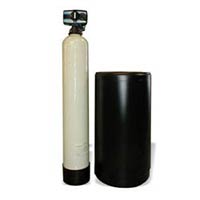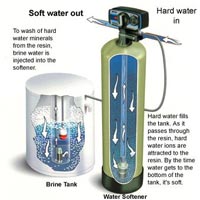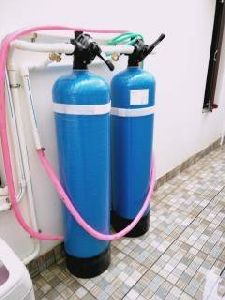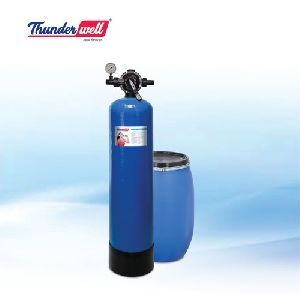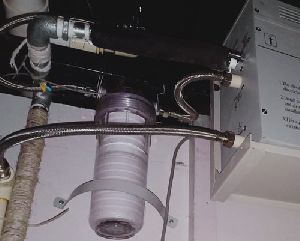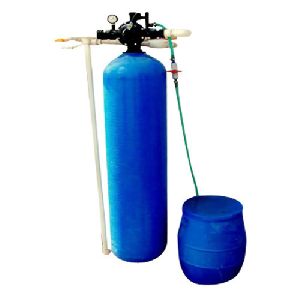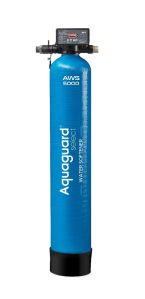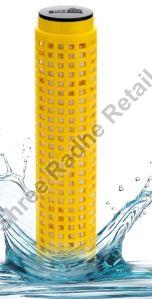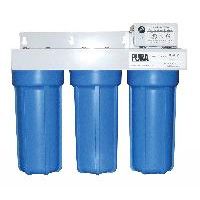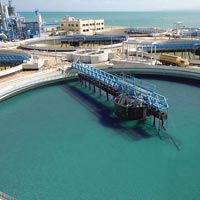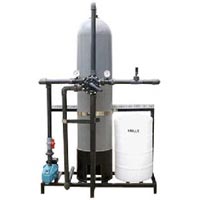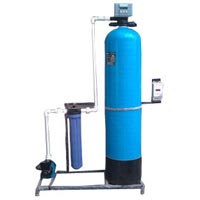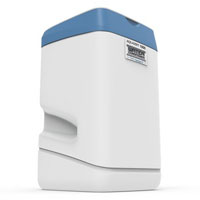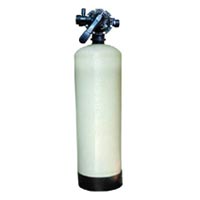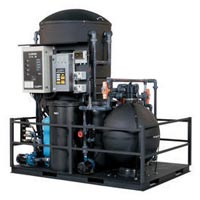Listing ID #1967761
Company Information
Ask for more detail from the seller
Contact Supplier
Our Water Softener removes or renders inactive and isolate minerals, such as Calcium, Magnesium fro Hard Water. Water containing dissolved calcium and magnesium in amount greater than 120mg. /1 is considered hard, this water destroys the detergent property of soaps. On heating & cooling, it forms scales which corrode. Our Water Softener is made using premium quality of raw materials and is widely demanded in the global markets. We also offer to design it as per the required technical specifications. Moreover, these are easy to install.
Saves you from ill effects of hard water like
Damage to water related appliances like water heater, pipes, dishwasher, and washing machineGraying and fading out of clothingItchy Scalp, dry skin, dry hairHard water spots on dishware and glassware
We ULTRA’S SKF have developed a service-oriental infrastructure of specialization with present maintenance support level as follows :
Response Time : 06 Hours on an averageDown Time : 24 Hours at maximum on averageStand by support : In case longer breakdownsAMC : Competitive
Why to use Water Softeners?
Hard water can and will destroy you water using appliances like your water heater, pipes, dishwasher, and washing machine. Hard water will also make your clothing look grey and faded out. Dry skin and dry hair is very common with hard water and can become quite itchy. You will also see hard water spots all over your dishware and glassware, which can be very annoying and bothersome.
How Does a Water Softener Work?
A water softener uses a medium that serves to exchange "ions" of calcium and magnesium with sodium and potassium.
This occurs in four steps :
To do the ion replacement, the water in the house runs through a resin bed of small plastic beads or zeolite. The beads are covered with sodium (salt) or potassium ions. As the water flows past the ions, they swap places with the calcium and magnesium ions. Eventually, the beads contain nothing but calcium and magnesium, and after 15/20 days softening stops. It is then time to regenerate the beads or zeoliteTo regenerate, the beads need to regain their sodium or potassium ions by being flooded with a salty, brine solution that is rich in sodium or potassiumOnce completed, the calcium and magnesium, dirt and sediments are flushed from the beads and into the drain in a process called backwashThe final phase rinses the mineral tank with fresh water and loads the brine tank so it's ready for the next cycle for another 15/20 days
Water Softener Quick Sizing Chart
This chart will help you to choose a water softener size that is right for your needs. You will need to know the number of people in your household and the grains of hardness per gallon in your water. If you need a quick and easy hardness testing kit, go to our Water Test Kit page.
Number of People123456780-1024k24k24k32k32k32k40k40k11-2024k24k32k32k40k40k40k48k21-3032k32k40k40k48k48k48k64k31-4040k40k48k48k48k64k64k80k41-5064k64k80k80k80k96k96k110k51-7564k80k80k96k96k110k110k110k76-10080k80k96k96k110k110k110k110k
This reference guide is based on every 4th night regeneration.
*Additional person compensates for water using appliances.
Formula for sizing softeners
Capacity = No. of People x Hardness x 70 Gallons x Days Between Regeneration
Ex: A family has 4 people with 33 grains per gallon hardness with no iron.
4 + 1(for appliances) x 33 Grains/Gal. x 70 Gallons x 4 Days = 46,200 Grains. In this example, 46,200 grains of capacity is needed on average every 4 days. Because no iron is present, the low salt setting can be used. Select the softener that will provide more than 46,200 grains at the low salt setting.
A water softener will remove clear water iron (iron in solution). When removing iron with a softener, compensate the hardness by a factor of 5 grains per gallon for every part per million of iron.
Ex: A family has 3 people with 22 grains per gallon hardness and 3 parts per million iron.
3 + 1(for appliances) x 37 Grains/Gal. x 70 Gallons x 2 Days = 20,720 Grains. In this example, 20,720 grains of capacity is needed on average every 2 days. With iron present, the softener should regenerate every other night and use the medium salt setting. Select the softener that will provide more than 21,000 grains at the medium salt setting
The Process of Deionization or Ion-exchange
In the context of water purification, ion-exchange is a rapid and reversible process in which impurity ions present in the water are replaced by ions released by an ion-exchange resin. The impurity ions are taken up by the resin, which must be periodically regenerated to restore it to the original ionic form. (An ion is an atom or group of atoms with an electric charge. Positively-charged ions are called cations and are usually metals; negatively-charged ions are called anions and are usually non-metals).
The following ions are widely found in raw waters :
CationsAnionsCalcium (Ca2+)Chloride (Cl-)Magnesium (Mg2+) Bicarbonate (HCO3-)Sodium (Na+)Nitrate (NO3-)Potassium (K+)Carbonate (CO32-)Iron (Fe2+)Sulfate (SO42-)
Ion Exchange Resins
There are two basic types of resin - cation-exchange and anion-exchange resins. Cation exchange resins will release Hydrogen (H+) ions or other positively charged ions in exchange for impurity cations present in the water. Anion exchange resins will release hydroxyl (OH-) ions or other negatively charged ions in exchange for impurity anions present in the water.
The application of ion-exchange to water treatment and purification
There are three ways in which ion-exchange technology can be used in water treatment and purification: first, cation-exchange resins alone can be employed to soften water by base exchange; secondly, anion-exchange resins alone can be used for organic scavenging or nitrate removal; and thirdly, combinations of cation-exchange and anion-exchange resins can be used to remove virtually all the ionic impurities present in the feedwater, a process known as deionization. Water deionizers purification process results in water of exceptionally high quality.
Deionization
For many laboratory and industrial applications, high-purity water which is essentially free from ionic contaminants is required. Water of this quality can be produced by deionization.The two most common types of deionization are:
5. Two-bed deionization6. Mixed-bed deionization
Two-bed deionization
The two-bed deionizer consists of two vessels - one containing a cation-exchange resin in the hydrogen (H+) form and the other containing an anion resin in the hydroxyl (OH-) form. Water flows through the cation column, whereupon all the cations are exchanged for hydrogen ions.To keep the water electrically balanced, for every monovalent cation, e.g. Na+, one hydrogen ion is exchanged and for every divalent cation, e.g. Ca2+, or Mg2+, two hydrogen ions are exchanged. The same principle applies when considering anion-exchange. The decationised water then flows through the anion column. This time, all the negatively charged ions are exchanged for hydroxide ions which then combine with the hydrogen ions to form water (H2O).
Mixed-bed deionization
In mixed-bed deionizers the cation-exchange and anion-exchange resins are intimately mixed and contained in a single pressure vessel. The thorough mixture of cation-exchangers and anion-exchangers in a single column makes a mixed-bed deionizer equivalent to a lengthy series of two-bed plants. As a result, the water quality obtained from a mixed-bed deionizer is appreciably higher than that produced by a two-bed plant.
Although more efficient in purifying the incoming feedwater, mixed-bed plants are more sensitive to impurities in the water supply and involve a more complicated regeneration process. Mixed-bed deionizers are normally used to ‘polish' the water to higher levels of purity after it has been initially treated by either a two-bed deionizer or a reverse osmosis unit.
Electrodeionization EDI Electrodeionization Systems remove ions from aqueous streams, typically in conjunction with reverse osmosis (RO) and other purification devices. Our high-quality deionization modules continually produce ultrapure water up to 18.2MW/cm. EDI may be run continuously or intermittently
STAGE 5 & 6 - DEIONIZATION
Fundamentals of Deionization by Ion Exchange
Deionization is a method used most often by laboratories to produce purified water on demand. All naturally-occurring water contains dissolved mineral salts. In solution, salts separate into positively-charged cations and negatively-charged anions. Deionization can reduce the amounts of these ions to very low levels through the process of ion exchange.
Cations are removed by cation exchange resin. It replaces sodium, calcium, magnesium, and other cations with hydrogen ions (H+). This exchange produces acids which must be removed or neutralized by anion exchange resin.
Two general types of anion resin are used for deionization: weak base resin and strong base resin. Weak base resin adsorbs strong acids, while strong base resin exchanges chloride, sulfate and alkaline anions for hydroxide ions (OH-). The hydrogen ions from the cation exchange process combine with the hydroxide ions from the anion exchange process to form water (HOH or H2O).
Because the deionization process is so effective, the water quality is usually measured by the water's resistance to electric current (in OHM-cm). Deionized water quality depends on a variety of factors, including raw water composition, ion exchange types and quantities, and the number of resin tanks in the system.
Two-bed deionizers use separate tanks, one containing cation resin, the other containing anion resin. A two-bed weak vase deionizer typically produces water with electrical resistance of about 50 kOHM-cm. A two-bed strong base deionizer typically produces water with electrical resistance of about 200 kOHM-cm.
In a mixed bed deionizer, cation and anion resins are thoroughly mixed in a single tank. The mixed resins act like a series of alternating cation and anion exchange tanks to produce very high quality water. A mixed-bed deionizer typically produces water with greater than 10 megOHM-cm resistance which is equivalent to less than 0.05 mg/L of sodium chloride.
The resins need regeneration when they no longer produce the desired water quality. In the case of a two-bed deionizer, the cation tank is backwashed for 5 to 10 minutes, then washed with a solution of acid. Then the anion tank is backwashed and washed with a solution of caustic. After rinsing the residual chemicals from each tank, water flows through both tanks to drain until the water reaches the desired quality.
In a mixed-bed deionizer, the resins have to be separated before regeneration. After regeneration and rinsing, they have to be remixed, using air, before returning to service. Although the process is fairly simple in concept, its application is complicated by different variables.


